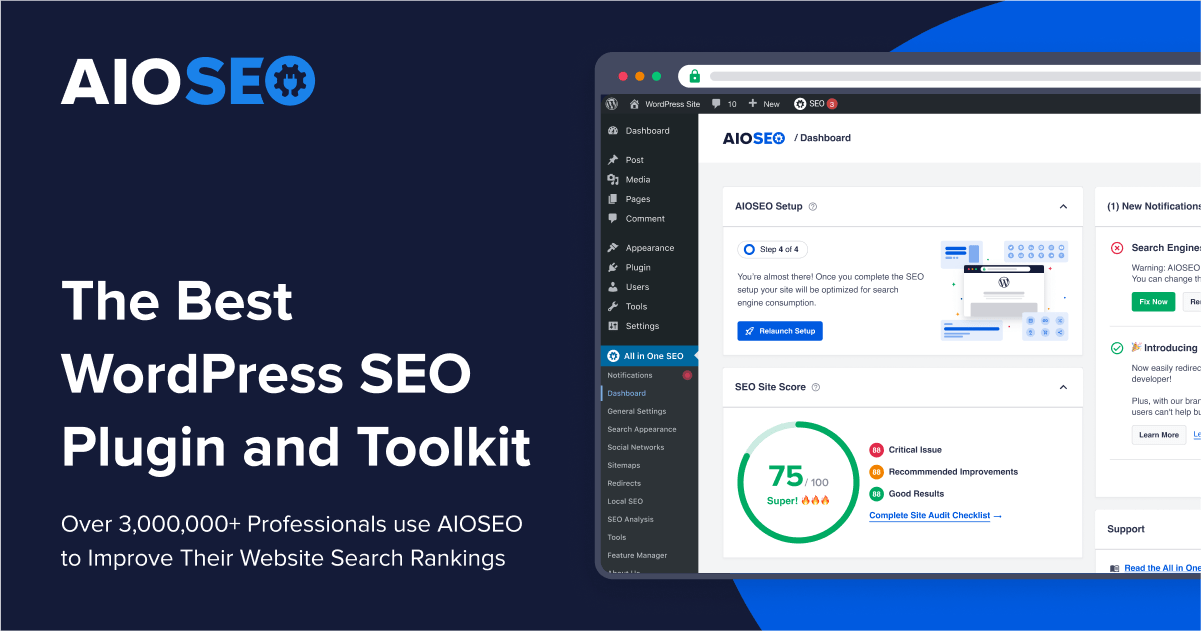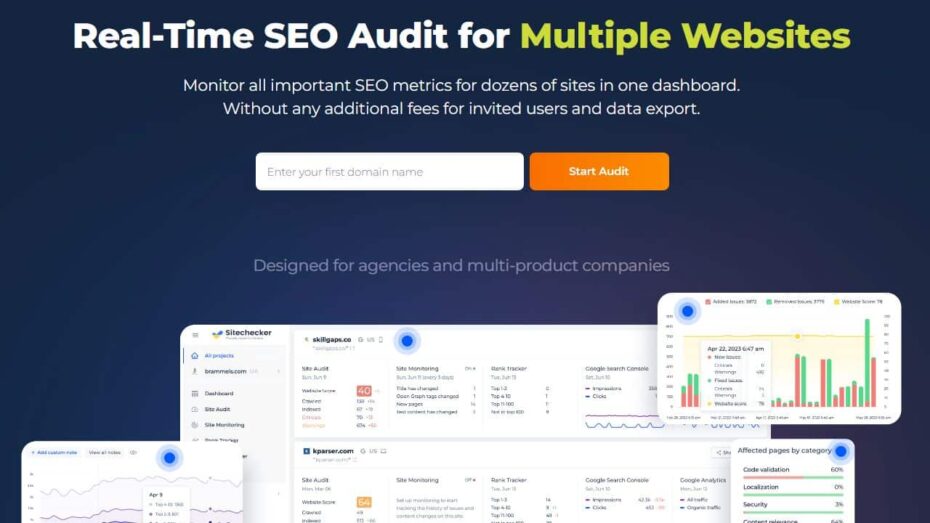Creating and managing a successful blog requires the right tools to streamline your workflow and enhance productivity. Discover the best blogging tools that can transform your content creation process and elevate your blogging experience.
Essential Features of the Best Blogging Tools
When selecting the best blogging tools, it’s crucial to consider the features that will enhance your content creation and management experience. These tools should offer a range of functionalities to make your blogging journey smoother and more efficient.
I believe that understanding these essential features can significantly improve your blogging process. By focusing on tools with user-friendly interfaces, integration capabilities, and customization options, you can streamline your workflow and create high-quality content consistently.
SEO Services Recommendations
 AIOSEO
|  Sitechecker
|  Squirrly
|
User-Friendly Interfaces for Seamless Navigation
A user-friendly interface is one of the most critical features of the best blogging tools. It ensures that you can navigate the tool easily without needing extensive technical knowledge. This accessibility allows you to focus more on content creation rather than figuring out how to use the tool.
My advice is to look for tools that offer intuitive dashboards and clear menus. These features can save you a lot of time and frustration. For instance, drag-and-drop editors are excellent for simplifying the content creation process, making it easy to format text, add images, and embed media.
Additionally, user-friendly interfaces often come with helpful tutorials and customer support. This support can be invaluable when you encounter any issues or need to learn new features. I strongly believe that investing in tools with excellent user interfaces will pay off in the long run, enhancing your overall productivity and blogging satisfaction.
Integration Capabilities with Other Platforms
The best blogging tools should also offer robust integration capabilities with other platforms. This feature is essential for streamlining your workflow and ensuring that all your tools work seamlessly together.
I suggest looking for blogging tools that integrate well with social media platforms, email marketing services, and analytics tools. These integrations can help you automate tasks such as sharing new blog posts on social media or tracking your blog’s performance metrics in real time.
Moreover, integration with content management systems (CMS) like WordPress can be a significant advantage. It allows you to manage your blog and website from a single platform, reducing the need to switch between multiple tools. My recommendation is to prioritize tools that offer a wide range of integrations to enhance your blogging efficiency.
Most importantly, ensure that the integrations are easy to set up and use. Complicated integration processes can be counterproductive, leading to wasted time and potential errors. Therefore, choose tools that offer straightforward, user-friendly integration options.
Customization Options for Personalized Experiences
Customization options are another vital feature of the best blogging tools. These options allow you to tailor the tool to meet your specific needs and preferences, enhancing your overall blogging experience.
I advise looking for tools that offer a high degree of customization in terms of design, functionality, and workflow. For example, customizable templates and themes can help you create a unique and professional-looking blog without needing extensive design skills.
Furthermore, the ability to customize workflows and automation rules can significantly improve your productivity. Tools that let you set up custom workflows for content creation, editing, and publishing can help you streamline your processes and ensure consistency across your blog.
Additionally, consider tools that offer personalized analytics and reporting features. These features allow you to track the metrics that matter most to you, providing valuable insights into your blog’s performance. I point out that customization options are key to creating a blogging tool that works perfectly for your unique needs, ultimately enhancing your content creation process and overall blogging success.
Content Creation Tools for Bloggers
Creating engaging and high-quality content is the cornerstone of successful blogging. Content creation tools are essential for bloggers to produce flawless articles, captivating visuals, and optimized content that ranks well in search engines.
I strongly believe that investing in the right content creation tools can make a significant difference in your blogging journey. These tools help streamline the writing process, enhance the visual appeal of your blog, and ensure that your content reaches a broader audience through effective SEO strategies.
Writing and Editing Software for Flawless Content
Writing and editing software are vital for producing clear, error-free content. These tools help you organize your thoughts, structure your articles, and polish your writing to perfection.
I recommend using tools like Grammarly or Hemingway Editor, which provide real-time grammar and style suggestions. These tools can significantly improve the readability and professionalism of your blog posts.
Additionally, writing software like Scrivener offers advanced organizational features, making it easier to manage long-form content and research. Moreover, many writing tools come with built-in distraction-free modes, allowing you to focus solely on your writing. This feature can enhance your productivity and help you produce high-quality content more efficiently. My suggestion is to explore various writing and editing software to find the one that best suits your needs and workflow.
Most importantly, these tools often include collaboration features, enabling multiple authors to work on a single document seamlessly. This can be particularly useful for bloggers who work with guest writers or have a team of contributors.
💡 Pro Tip: If you’re hunting for a broader list of powerful writing tools beyond this roundup, I suggest checking out this detailed guide on the best online tools for writers. It covers everything from grammar checkers to distraction-free editors — especially useful if you write across formats like blogs, eBooks, and academic content.
Visual Design Tools to Enhance Blog Aesthetics
Visual design tools are essential for creating attractive and engaging blog posts. These tools help you design eye-catching graphics, infographics, and other visual elements that can make your content more appealing to readers.
I believe that tools like Canva and Adobe Spark are excellent choices for bloggers. These platforms offer a wide range of templates and design elements that you can customize to match your blog’s aesthetic. They are user-friendly and do not require advanced design skills, making them accessible to everyone.
Furthermore, visual design tools can help you create consistent branding across your blog and social media channels. This consistency can strengthen your brand identity and make your blog more recognizable. I advise experimenting with different design tools to find the one that best aligns with your creative vision.
Additionally, using high-quality images and graphics can improve the overall user experience on your blog. Engaging visuals can keep readers interested and encourage them to spend more time on your site, which can positively impact your SEO rankings.
SEO Tools to Boost Blog Visibility
SEO tools are crucial for ensuring that your blog content reaches a wider audience. These tools help you optimize your articles for search engines, making it easier for potential readers to find your content online.
I suggest using tools like RankMath or SEMrush, which provide comprehensive SEO analysis and recommendations. These tools can guide you in optimizing your keywords, meta descriptions, and headings to improve your search engine rankings. They also offer insights into your competitors’ strategies, helping you stay ahead in the blogging game.
Most importantly, SEO tools often include features like keyword research and backlink analysis. These features can help you identify valuable keywords to target and build a strong backlink profile, both of which are essential for boosting your blog’s visibility. My recommendation is to integrate SEO tools into your content creation process to ensure that your articles are optimized from the start.
Additionally, many SEO tools offer content analysis and readability scores, helping you create content that is both user-friendly and search engine-friendly. This dual focus can significantly enhance your blog’s performance and attract more organic traffic.
Time-Saving Tools for Efficient Blogging
Efficient blogging requires tools that help you save time and streamline your workflow. Time-saving tools are essential for managing your blogging schedule, automating repetitive tasks, and tracking the performance of your content.
I believe that incorporating these tools into your blogging routine can significantly enhance your productivity. By leveraging content planning, automation, and analytics tools, you can focus more on creating high-quality content and less on administrative tasks.
Content Planning and Scheduling Tools
Content planning and scheduling tools are crucial for maintaining a consistent publishing schedule. These tools help you organize your content calendar, plan future posts, and ensure that you never miss a deadline.
I recommend using tools like Trello or Asana for content planning. These platforms offer visual boards and task lists that make it easy to map out your content strategy. You can assign tasks, set deadlines, and track progress, all in one place. This organization can help you stay on top of your blogging commitments and keep your content pipeline flowing smoothly.
Most importantly, scheduling tools like Sproutsocial or Buffer allow you to automate the publishing process. These tools enable you to schedule blog posts and social media updates in advance, ensuring that your content goes live at optimal times. My suggestion is to integrate these tools into your workflow to maintain a steady content output and engage your audience consistently.
Additionally, these tools often come with collaboration features, making it easier to work with a team. You can share your content calendar with contributors, assign roles, and track the status of each task, enhancing overall efficiency.
Automation Tools for Repetitive Tasks
Automation tools are essential for handling repetitive tasks that can consume a significant amount of your time. These tools can automate processes like social media posting, email marketing, and content distribution, freeing up more time for content creation.
I advise using tools like Zapier or IFTTT to automate your blogging tasks. These platforms allow you to create automated workflows between different apps and services. For example, you can set up a workflow that automatically shares new blog posts to your social media channels or emails your subscribers when a new post is published.
Moreover, automation tools can help you manage your email marketing campaigns more efficiently. Tools like Aweber or Mailmunch allow you to automate email sequences, segment your audience, and track engagement metrics. I think these features can significantly enhance your marketing efforts and improve your audience engagement.
Most importantly, automation tools reduce the risk of human error and ensure that tasks are completed consistently and accurately. My recommendation is to explore different automation tools to find the ones that best fit your blogging needs and can help streamline your workflow.
Analytics Tools to Track Performance
Analytics tools are vital for tracking the performance of your blog and understanding how your content is resonating with your audience. These tools provide insights into your blog’s traffic, engagement, and overall effectiveness.
I suggest using tools like Hotjar or Kissmetrics to monitor your blog’s performance. These platforms offer comprehensive analytics dashboards that show key metrics such as page views, bounce rates, and visitor demographics. By analyzing this data, you can identify which types of content are most popular and which areas need improvement.
Additionally, many analytics tools provide real-time data, allowing you to make informed decisions quickly. I recommend setting up regular analytics reviews to track your progress and adjust your strategy as needed. This proactive approach can help you stay on top of trends and optimize your content for better performance.
Furthermore, integrating analytics tools with your SEO and content management platforms can provide a more holistic view of your blog’s performance. By combining these insights, you can create more effective content strategies and improve your blog’s overall impact. I point out that using analytics tools is essential for any serious blogger looking to grow their audience and achieve long-term success.
Collaboration Tools for Blogging Teams
Efficient collaboration is essential for blogging teams to produce high-quality content consistently. Collaboration tools are designed to streamline communication, project management, and real-time editing, ensuring that all team members are on the same page.
I believe that using the best collaboration tools can greatly enhance your team’s productivity and cohesion. These tools help manage tasks, facilitate communication, and allow for seamless real-time collaboration, making the blogging process more efficient and enjoyable.
Real-Time Collaboration Software
Real-time collaboration software is crucial for blogging teams that need to work together on content creation simultaneously. These tools allow multiple users to edit, comment, and make changes to documents in real time.
I recommend using platforms like Google Docs or Microsoft OneDrive. These tools offer real-time editing features, allowing team members to see changes as they happen. This capability is particularly useful for co-authoring blog posts, as it ensures that all contributors can work together seamlessly without version conflicts.
My suggestion is to take advantage of the commenting and suggestion features available in these tools. These features enable team members to provide feedback and propose changes directly within the document, streamlining the review and approval process. This collaborative approach can lead to higher-quality content and faster turnaround times.
Moreover, real-time collaboration software often includes built-in version history. This feature allows you to track changes over time and revert to previous versions if necessary. I strongly believe that having a reliable version control system is essential for maintaining the integrity of your content.
Project Management Tools for Team Efficiency
Project management tools are essential for organizing tasks, setting deadlines, and tracking progress within a blogging team. These tools help ensure that everyone knows their responsibilities and stays on track to meet deadlines.
I advise using tools like Trello or Asana for project management. These platforms offer visual boards and task lists that make it easy to assign tasks, set due dates, and monitor progress. This organization can help your team stay on top of their workload and ensure that projects are completed on time.
Most importantly, project management tools often include features like calendar views and timeline tracking. These features provide a clear overview of upcoming deadlines and milestones, helping your team prioritize tasks effectively. My recommendation is to regularly update and review your project management board to keep everyone aligned and focused.
Additionally, many project management tools offer integration with other collaboration and communication tools. This integration allows for seamless information flow between different platforms, enhancing overall efficiency and reducing the risk of miscommunication.
Communication Tools for Seamless Coordination
Effective communication is the backbone of any successful blogging team. Communication tools facilitate quick and efficient exchanges of information, ensuring that all team members are informed and connected.
I suggest using tools like Slack or Microsoft Teams for team communication. These platforms offer real-time messaging, file sharing, and video conferencing capabilities, making it easy to stay in touch with team members regardless of location. This instant communication can help resolve issues quickly and keep projects moving forward.
Moreover, communication tools often include channels or groups, allowing you to organize conversations by topic or project. This organization can help keep discussions focused and relevant, reducing the clutter in your communication streams. I point out that creating dedicated channels for specific projects or tasks can enhance clarity and efficiency.
Furthermore, many communication tools offer integration with other collaboration and project management platforms. This integration allows you to share updates, files, and task assignments directly within your communication tool, streamlining your workflow and keeping all relevant information in one place.
Most importantly, regular communication fosters a sense of team cohesion and collaboration. I believe that scheduling regular check-ins and meetings can help keep everyone aligned and motivated, leading to a more productive and harmonious working environment.
Monetization Tools for Bloggers
Monetization tools are essential for bloggers looking to generate revenue from their content. These tools offer various ways to earn income, from affiliate marketing to ad management and e-commerce integration, helping bloggers turn their passion into a profitable venture.
I believe that leveraging the right monetization tools can significantly boost your blog’s earning potential. By exploring different monetization strategies and integrating the appropriate tools, you can create multiple income streams and enhance your blog’s financial sustainability.
Affiliate Marketing Platforms
Affiliate marketing platforms are an excellent way for bloggers to earn commissions by promoting products and services. These platforms connect you with affiliate programs that match your blog’s niche, allowing you to earn a commission on sales generated through your referral links.
I recommend using platforms like FlexOffers , ShareASale, or Commission Junction. These platforms offer a wide range of affiliate programs, giving you the flexibility to choose products that align with your content. By incorporating affiliate links naturally into your blog posts, you can provide value to your readers while generating income.
Most importantly, my advice is to focus on promoting products that you genuinely believe in and that are relevant to your audience. Authenticity is key in affiliate marketing, as readers are more likely to trust and purchase products that you personally endorse. Additionally, providing detailed reviews and tutorials can help increase your conversion rates.
Furthermore, many affiliate marketing platforms offer tools to track your performance and optimize your strategies. By analyzing your clicks, conversions, and earnings, you can refine your approach and maximize your affiliate income. I suggest regularly reviewing your affiliate marketing efforts to ensure they are effectively contributing to your overall monetization strategy.
Ad Management Tools for Revenue Generation
Ad management tools are another effective way to monetize your blog by displaying ads to your readers. These tools help you manage, optimize, and track ad placements, ensuring that you generate maximum revenue from your blog’s traffic.
I advise using platforms like Popads, AdRoll, or HilltopAds for ad management. These tools offer a range of ad formats, including display ads, video ads, and native ads, allowing you to choose the types that best suit your blog’s layout and audience. By strategically placing ads in high-visibility areas, you can increase your ad revenue.
My recommendation is to balance the number of ads with user experience. While ads can generate income, too many can be intrusive and drive readers away. I suggest experimenting with different ad placements and formats to find the right balance that maximizes revenue without compromising user experience.
Additionally, ad management tools provide valuable insights into your ad performance. By analyzing metrics such as click-through rates (CTR) and earnings per click (EPC), you can optimize your ad placements and improve your revenue. I strongly believe that regularly monitoring your ad performance and making data-driven adjustments is crucial for sustained ad revenue growth.
E-commerce Integration for Selling Products
E-commerce integration is a powerful way to monetize your blog by selling products directly to your audience. Whether you’re selling physical products, digital downloads, or online courses, integrating e-commerce functionality into your blog can create a significant revenue stream.
I recommend using platforms like WooCommerce, Shopify, or BigCommerce for e-commerce integration. These tools offer robust features for setting up an online store, managing inventory, and processing payments. By creating an online store that complements your blog, you can offer products that resonate with your audience and drive sales.
My advice is to focus on creating high-quality products that provide genuine value to your readers. Whether it’s exclusive merchandise, eBooks, or premium content, ensuring that your products meet the needs and preferences of your audience can boost your sales and enhance customer satisfaction.
Furthermore, leveraging e-commerce integration tools can streamline your sales process. Features like automated order processing, shipping management, and customer support can save you time and improve your operational efficiency. I point out that providing excellent customer service and maintaining a user-friendly online store are key factors in building a successful e-commerce business through your blog.
Security Tools to Protect Your Blog
Ensuring the security of your blog is crucial to protecting your content, data, and reputation. Security tools are essential for safeguarding your blog against potential threats such as data loss, malware, and unauthorized access.
I believe that investing in robust security tools can provide peace of mind and keep your blog safe from cyber threats. By implementing backup solutions, malware protection, and strong privacy settings, you can create a secure environment for your blog and its visitors.
Backup Solutions for Data Safety
Backup solutions are critical for safeguarding your blog’s data. These tools help you create regular backups of your content, ensuring that you can restore your blog quickly in case of data loss or corruption.
I recommend using backup tools like UpdraftPlus or Solid Backups for WordPress. These plugins offer automated backup schedules, making it easy to ensure that your data is consistently backed up without manual intervention. With these tools, you can store backups on remote servers, cloud storage, or even download them to your local system.
Most importantly, my suggestion is to schedule regular backups and test the restoration process. This practice ensures that your backups are reliable and that you can restore your blog quickly in an emergency. Regularly updating and verifying your backups can save you from significant data loss and downtime.
Furthermore, some backup solutions offer incremental backups, which only save changes made since the last backup. This feature reduces the time and storage space required for backups, making the process more efficient. I strongly believe that having a reliable backup solution is a fundamental step in protecting your blog’s data.
Malware and Virus Protection Tools
Malware and virus protection tools are essential for defending your blog against malicious attacks. These tools help detect and remove harmful software that can compromise your blog’s security and performance.
I advise using security plugins like Wordfence or Sucuri for malware protection. These tools offer comprehensive security features, including malware scanning, firewall protection, and real-time threat detection. By regularly scanning your blog for malware, you can identify and address potential threats before they cause significant damage.
My recommendation is to enable real-time monitoring and automatic updates for your security tools. This practice ensures that your blog is continuously protected against new and emerging threats. Keeping your security tools up to date is crucial for maintaining a robust defense against cyber attacks.
Additionally, some malware protection tools offer features like IP blocking and login protection to prevent unauthorized access. These features add an extra layer of security to your blog, reducing the risk of brute force attacks and other unauthorized access attempts. I point out that comprehensive malware protection is vital for maintaining the integrity and security of your blog.
Privacy and Security Settings Management
Managing privacy and security settings is essential for protecting your blog and its visitors. These settings help control access to your blog’s content and data, ensuring that only authorized users can make changes or access sensitive information.
I suggest using tools like Solid Security or All In One WP Security & Firewall for managing your privacy and security settings. These plugins offer a range of features, including user role management, two-factor authentication, and security audits. By configuring these settings, you can enhance your blog’s security and protect against unauthorized access.
Most importantly, I recommend regularly reviewing and updating your security settings. As your blog grows and evolves, your security needs may change. Regular audits and updates ensure that your blog’s security remains robust and up to date.
Furthermore, implementing two-factor authentication (2FA) can significantly enhance your blog’s security. 2FA requires users to provide two forms of verification when logging in, making it much harder for unauthorized users to gain access. I believe that strong privacy and security settings are essential for maintaining a secure and trustworthy blog.
Choosing the Right Blogging Tools
Choosing the right blogging tools is essential for creating a successful and efficient blogging experience. The right tools can help you streamline your workflow, enhance your content quality, and improve your blog’s overall performance.
I believe that selecting the appropriate blogging tools starts with understanding your specific needs and goals. By evaluating your requirements and comparing the available options, you can make informed decisions that will benefit your blog in the long run.
Evaluating Your Blogging Needs
Before you choose any blogging tools, it’s crucial to evaluate your specific blogging needs. This involves understanding the type of content you create, your audience, and your long-term goals.
I recommend starting by identifying the primary tasks you need help with. Are you looking for tools to improve your writing, manage your social media, or analyze your blog’s performance? Knowing what you need will help you narrow down your options and focus on tools that offer the features most relevant to your blog.
Most importantly, consider your technical skills and how comfortable you are with using new software. Some tools are more user-friendly and require less technical knowledge, while others offer more advanced features but come with a steeper learning curve. My advice is to choose tools that match your skill level to ensure you can use them effectively.
Additionally, think about the scalability of the tools you choose. As your blog grows, your needs may change, so it’s important to select tools that can grow with you. Look for options that offer flexible plans or additional features that you can access as your blog expands.
Comparing Features and Pricing
Once you’ve identified your needs, the next step is to compare the features and pricing of different blogging tools. This comparison will help you determine which tools offer the best value for your investment.
I suggest creating a list of must-have features and nice-to-have features for your blogging tools. This list will help you evaluate each tool based on how well it meets your requirements. Consider factors such as ease of use, integration with other tools, and customer support when making your comparisons.
My recommendation is to also consider the pricing models of the tools you are evaluating. Some tools offer one-time purchases, while others operate on subscription-based models. Compare the costs over time to determine which option fits your budget best. Don’t forget to look for discounts or free trials that can help you test the tools before committing.
Moreover, some tools offer bundled features that can provide additional value. For example, a tool that includes both content planning and social media scheduling might be more cost-effective than purchasing two separate tools. I believe that thorough research and comparison are key to finding the best tools for your blog.
Reading Reviews and Seeking Recommendations
Reading reviews and seeking recommendations from other bloggers can provide valuable insights into the effectiveness and reliability of different blogging tools. User feedback can highlight the pros and cons of each tool, helping you make more informed decisions.
I advise starting by reading reviews on trusted websites and forums. Look for detailed reviews that discuss both the strengths and weaknesses of the tools. Pay attention to any recurring issues or praises, as these can give you a better understanding of what to expect.
Most importantly, consider seeking recommendations from bloggers within your niche. They are likely to have experience with tools that are particularly relevant to your type of content and audience. Joining blogging communities or forums can be a great way to connect with other bloggers and get their insights.
Additionally, many tools offer case studies or testimonials from users. These can provide examples of how the tools have helped other bloggers achieve their goals. I strongly believe that gathering as much information as possible from various sources will help you make the best choice for your blogging needs.
By evaluating your needs, comparing features and pricing, and seeking reviews and recommendations, you can confidently choose the right blogging tools that will support your content creation and growth efforts.
Frequently Asked Questions (FAQ)
What are the best blogging tools for beginners?
Which blogging platform is the most popular?
WordPress is the most popular blogging platform, powering over 40% of all websites on the internet. It offers extensive customization options, a large number of plugins, and a strong community support system, making it ideal for both beginners and experienced bloggers.
How can I choose the right blogging tools for my needs?
What are the essential SEO tools for blogging?
Essential SEO tools for blogging include Serpstat for backlink analysis, Sitechecker for comprehensive SEO audits, Moz for keyword research, and Squirrly for on-page optimization within WordPress. These tools help improve your blog’s visibility on search engines.
Can I use free blogging tools effectively?
Yes, many free blogging tools are highly effective. WordPress itself has a free version, while tools like Woopra provide in-depth insights. Canva offers free graphic design capabilities, and Aweber has a free plan for managing your email marketing. Combining these tools can help you start a blog without significant upfront costs.
What are the best tools for content creation?
The best tools for content creation include Grammarly for grammar and spell-check, Hemingway Editor for readability improvement, and Canva for creating visuals. These tools streamline the writing and editing process, ensuring your content is polished and engaging.
Which social media tools are ideal for promoting my blog?
What tools can help with email marketing for my blog?
Tools like Mailmunch and ConvertKit are excellent for email marketing. They offer features like automated email sequences, list segmentation, and analytics to track your campaigns. These tools help you engage with your audience and drive traffic back to your blog.
How can analytics tools improve my blog’s performance?
Analytics tools like Google Analytics provide detailed insights into your blog’s traffic, including visitor behavior, traffic sources, and conversion rates. This data allows you to refine your content strategy, target the right audience, and improve overall blog performance.
What are the best tools for monetizing a blog?
For monetizing a blog, tools like Monetag for display ads, Affiliate Marketing platforms like MyLead, and E-commerce plugins like BigCommerce for selling products or services are highly effective. These tools help you generate revenue from your blog in various ways.








